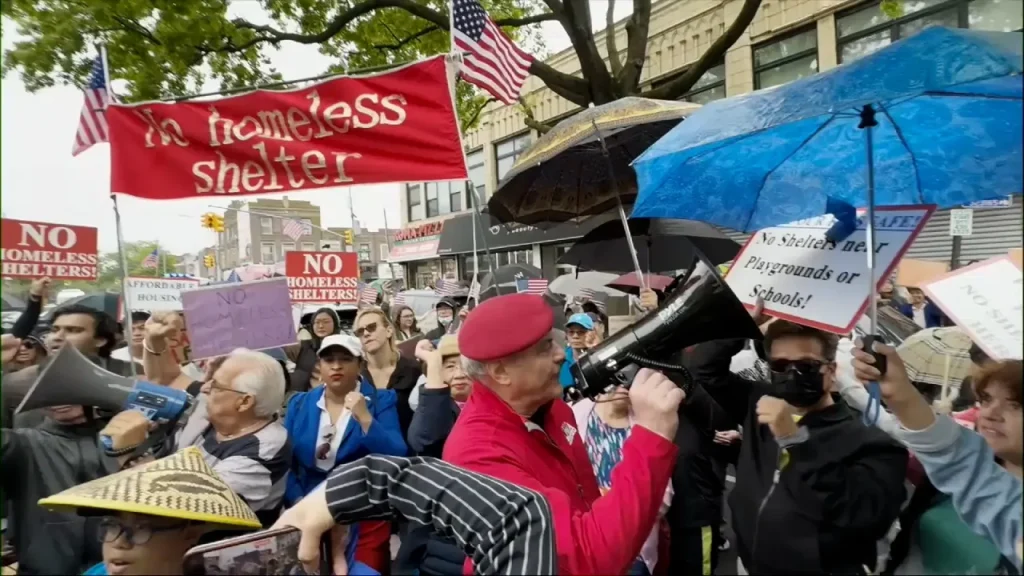Demonstrators in Brooklyn, New York, protested over the weekend against city plans to transform a previously approved site for affordable housing into a homeless shelter. This change, which residents claim was enacted without proper community input, has sparked frustration and anger. Led by mayoral candidate Curtis Sliwa, the protest saw hundreds of participants march through Sheepshead Bay, voicing their concerns over the proposed shelter and calling for accountability from local officials.
| Article Subheadings |
|---|
| 1) Community Outrage Over Shelter Plans |
| 2) History of the Proposed Housing Site |
| 3) Voices of Concern from Residents |
| 4) The Role of Local Leaders |
| 5) Implications for Future Housing Policies |
Community Outrage Over Shelter Plans
In a demonstration that captivated local attention, community members took to the streets of Brooklyn this past Sunday to voice their dissatisfaction with city officials’ recent decision to convert a site originally designated for affordable housing into a homeless shelter. The protest was organized following an announcement by the city that a shelter would be built at 2134 Coyle Street, a location locals had championed for much-needed affordable housing as recently as 2022. Many attendees expressed their feelings through various slogans and chants, including “Vote them out” and “Children’s safety first, no homeless shelters!” This public outcry reflects deep-rooted anxieties about the implications of such changes in urban planning.
History of the Proposed Housing Site
The Coyle Street site has a complicated history within the community. Initially approved in 2021, the plan included a five-story mixed-use building with 120 apartments, of which 36 units were earmarked as permanently affordable housing. However, with the withdrawal of a key developer in 2023, city officials shifted gears, proposing instead to repurpose the site for a 175-unit homeless shelter aimed at families with children who have nowhere else to go. This abrupt change has led residents to feel blindsided, as the city had previously assured them that the site would remain dedicated to affordable housing.
Voices of Concern from Residents
As the protest unfolded, many residents shared their concerns about the proposed homeless shelter. One such protester, Fruma Feldman, a 21-year-old local, articulated her fears regarding the safety of the shelter environment. Her father, she mentioned, has friends who are homeless but are apprehensive about entering shelters due to concerns about crime and violence. “I don’t think it should be here,” she stated. Her sentiments were echoed by others, who believe that while support for the homeless community is essential, the placement of shelters in residential areas can lead to increased safety risks for families and children.
The Role of Local Leaders
Leading the charge at the protest was mayoral candidate and founder of the Guardian Angels, Curtis Sliwa. He urged the gathered crowd to take action against what he termed a “bait-and-switch” by city officials. Sliwa emphasized the need for community solidarity and remarked, “If you didn’t see your elected official here, I don’t care if you’re a Democrat or a Republican, clearly they were on the side of having a shelter.” His passionate plea resonated with many who feel that their voices have been ignored in the planning processes affecting their neighborhoods. The protest not only highlighted the community’s frustration but also called into question the accountability of local leaders.
Implications for Future Housing Policies
The recent protests in Brooklyn highlight a critical issue in urban planning and local governance—the delicate balance between providing necessary services for vulnerable populations and maintaining community safety and integrity. The shift from affordable housing to homelessness solutions has sparked a debate about the future direction of city planning policies. As pressure mounts on city officials to listen to community feedback, it raises questions about how urban development decisions will be made moving forward. The outcome of this situation may serve as a precedent for other neighborhoods grappling with similar issues of housing and shelter placement.
| No. | Key Points |
|---|---|
| 1 | Local residents protested against changes to a housing site in Brooklyn. |
| 2 | The original plan involved affordable housing, which was shifted to a homeless shelter. |
| 3 | Protesters expressed concerns about safety for children and families. |
| 4 | Mayoral candidate Curtis Sliwa played a key role in the demonstration. |
| 5 | This situation may influence future urban planning policies in Brooklyn. |
Summary
The protest in Brooklyn signifies growing frustrations among residents regarding the city’s handling of housing plans. As the community rallies against the proposed homeless shelter that replaces an affordable housing project, the event highlights critical issues of public safety, government accountability, and the need for transparent dialogue between residents and city officials. The outcome of this debate could shape future urban policies and community relations in Brooklyn and beyond.
Frequently Asked Questions
Question: What prompted the protests in Brooklyn?
The protests were sparked by community outrage over the city’s decision to convert a site, initially planned for affordable housing, into a homeless shelter.
Question: Who led the demonstration against the shelter?
The demonstration was led by mayoral candidate Curtis Sliwa, who criticized local officials for their handling of the situation.
Question: What are the community’s main concerns about the proposed shelter?
Residents expressed fears about safety, particularly regarding the potential impact on children and families living nearby, as well as concerns about the shelter’s environment attracting crime.


